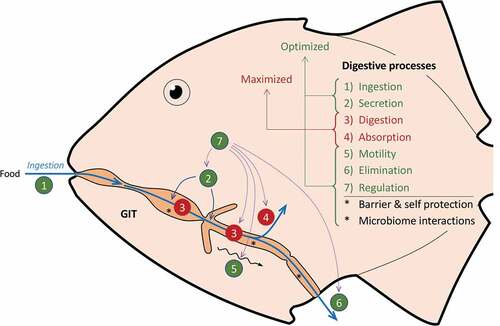Figures & data
Figure 1. (a) Changes in standard metabolic rate (SMR) and maximum metabolic rate (MMR) and aerobic scope (AS) as a function of temperature in fish; (b) Performance curve as a function of temperature. Performance is maximal at an optimal temperature (Topt). Performance can no longer be sustained at temperatures below the minimal critical temperature (CTmin) or beyond the maximal critical temperature (CTmax) [based on [Citation18]]
![Figure 1. (a) Changes in standard metabolic rate (SMR) and maximum metabolic rate (MMR) and aerobic scope (AS) as a function of temperature in fish; (b) Performance curve as a function of temperature. Performance is maximal at an optimal temperature (Topt). Performance can no longer be sustained at temperatures below the minimal critical temperature (CTmin) or beyond the maximal critical temperature (CTmax) [based on [Citation18]]](/cms/asset/3a669816-4ab2-465a-b324-b41cb2760f56/ktmp_a_1765950_f0001_oc.jpg)
Figure 2. Thermal tolerance polygon for Atlantic salmon. The purple area outlines the tolerance zone while the blue area is the limit for food intake. The incipient lethal temperature (incipient Ct) is the temperature where 50% of individuals acclimated to a certain temperature can survive for a long time, in this study defined as 7 days. The ultimate lethal temperature (Ultimate Ct) is the highest temperature to which fish can acclimate [Citation123]. Note that both lower and upper limits for food intake, incipient, and ultimate lethal temperatures are positively correlated with acclimation temperature [modified from [Citation24]]
![Figure 2. Thermal tolerance polygon for Atlantic salmon. The purple area outlines the tolerance zone while the blue area is the limit for food intake. The incipient lethal temperature (incipient Ct) is the temperature where 50% of individuals acclimated to a certain temperature can survive for a long time, in this study defined as 7 days. The ultimate lethal temperature (Ultimate Ct) is the highest temperature to which fish can acclimate [Citation123]. Note that both lower and upper limits for food intake, incipient, and ultimate lethal temperatures are positively correlated with acclimation temperature [modified from [Citation24]]](/cms/asset/cb8be480-5395-4515-ac72-75afcf4947bb/ktmp_a_1765950_f0002_oc.jpg)
Figure 3. (a) Dynamic energy budget in a fish. Energy is provided by ingestion of food, which is processed in the gastrointestinal tract (GIT). Food undergoes digestion and portion of the digesta is absorbed, and some is not absorbed and is lost via the feces (egestion). Absorbed nutrients provide energy that is used for basal maintenance (SMR). Energy in excess is allocated to activity/locomotion, storage/reserves, somatic growth, or reproduction. Energy is also lost during processing of nutrients via SDA and some due to excretion of N-containing compounds, i.e. NH3 [based on [Citation124] and [Citation125]]. (b) General effects of temperature on performance (conversion efficiency) and rates of food intake, metabolic rate, and growth in fish. Numbers (1–3) indicate maxima (optima) in relation to temperature [modified from [Citation126]]
![Figure 3. (a) Dynamic energy budget in a fish. Energy is provided by ingestion of food, which is processed in the gastrointestinal tract (GIT). Food undergoes digestion and portion of the digesta is absorbed, and some is not absorbed and is lost via the feces (egestion). Absorbed nutrients provide energy that is used for basal maintenance (SMR). Energy in excess is allocated to activity/locomotion, storage/reserves, somatic growth, or reproduction. Energy is also lost during processing of nutrients via SDA and some due to excretion of N-containing compounds, i.e. NH3 [based on [Citation124] and [Citation125]]. (b) General effects of temperature on performance (conversion efficiency) and rates of food intake, metabolic rate, and growth in fish. Numbers (1–3) indicate maxima (optima) in relation to temperature [modified from [Citation126]]](/cms/asset/82166141-2527-4fa7-9910-10b40efab0a5/ktmp_a_1765950_f0003_oc.jpg)
Figure 4. General overview of the endocrine regulation of feeding in fish. Information on the presence and composition of food in the gastrointestinal tract (GIT) is transmitted to the brainstem and subsequently the brain feeding centers via receptors [GIT hormone receptors as well as mechanoreceptors (stretch) and chemoreceptors] located on vagal afferents. Some GIT hormones also act via the circulation and cross the blood-brain barrier and affect the secretion of brain appetite hormones, which in turn affect feeding centers. AgRP, agouti-related peptide; CART, cocaine- and amphetamine-regulated transcript; CCK, cholecystokinin; CRF, corticotropin-releasing factor; GHRL, ghrelin; GLP, glucagon-like peptide; MCH, melanocyte-concentrating hormone; NPY, neuropeptide Y; OX, orexin; POMC, proopiomelanocortin; PYY, peptide YY. Hormones are characterized as orexigenic (green) or anorexigenic (red) if they stimulate or inhibit feeding, respectively
![Figure 4. General overview of the endocrine regulation of feeding in fish. Information on the presence and composition of food in the gastrointestinal tract (GIT) is transmitted to the brainstem and subsequently the brain feeding centers via receptors [GIT hormone receptors as well as mechanoreceptors (stretch) and chemoreceptors] located on vagal afferents. Some GIT hormones also act via the circulation and cross the blood-brain barrier and affect the secretion of brain appetite hormones, which in turn affect feeding centers. AgRP, agouti-related peptide; CART, cocaine- and amphetamine-regulated transcript; CCK, cholecystokinin; CRF, corticotropin-releasing factor; GHRL, ghrelin; GLP, glucagon-like peptide; MCH, melanocyte-concentrating hormone; NPY, neuropeptide Y; OX, orexin; POMC, proopiomelanocortin; PYY, peptide YY. Hormones are characterized as orexigenic (green) or anorexigenic (red) if they stimulate or inhibit feeding, respectively](/cms/asset/2f8630cc-b700-4b2d-9086-517a35839754/ktmp_a_1765950_f0004_oc.jpg)
Figure 5. Processes involved in digestion. After food is ingested (1), digestive juices are secreted (2) and allow enzymes to digest food to very simple molecules (3) that are transported across the intestinal epithelium into the blood (4). The food is actively transported through the gastro-intestinal tract (GIT) by smooth muscular movements (5). The remaining indigestible food is eventually evacuated (6). The gut transit time is the time from ingestion (1) to elimination (6). Digestion consists of closely orchestrated processes (7) that are integrated in ways that is believed to optimize efficiency and maximize absorption. *The GIT also has a very important function as a barrier to prevent entry of vectors for disease. Structural and enzymatic barriers are characteristic of the entire GIT. Microbiota and symbiotic digestion may occur not only in posterior section, but also in the anterior sections. Interactions between the digesta, microbiota, and gut tissue likely also occur

